If you have had your eyes and ears open at all in the last 5 years then you certainly would have noticed the lush, chill sounds of Lofi Music.
Used extensively by YouTubers like Casey Neistat to create cool and approachable vibes in their videos, this music is not showing any signs of losing its popularity.
I know when I want to create a nice chill vibe to do my cooking I put a LoFi Hip Hop playlist on, kick back and dice my courgettes.
The great thing about making lofi music is that it is not only fun to produce it is also super simple.
The trick to it is to get your head around the jazz-inspired harmonies (and the hip-hop beats of course).
I wanted to show you my favourite 13 Lofi chord progressions that you can use in your next Lofi track.

GET ALL THESE CHORD PROGRESSIONS AND MORE
If you want to get hold of the FREE MIDI files of these progressions in this post download my FREE Lofi Essentials Starter Pack
What is Lofi Music?
Lofi music refers to lo-fidelity music, which simply means a low-quality sound. This comes from the origins of lofi music in the 1950s, when musicians would use the cheapest gear they could find to record. As a result, the sound was often imperfect: mics would only capture mid-range frequencies, amps had a low-quality tone, and tape would wobble and crackle.
Because the gear naturally rolled off the higher frequencies, the resulting sound was warm and soft.
Fast forward to the 1980s and 90s, when producers began sampling old jazz recordings from vinyl and combining them with hip hop beats. They would tend to use slower tempos of 60-90bpm, use 808 drum machines for the kick and snare, and would often include found sound recordings to the mix.
This revival is what gave us the genre of lofi music and the lofi aesthetic we all know today.
What is the Lofi Aesthetic?
The lofi aesthetic is warm, soft, and imperfect. It's the sound of calm chords and mellow beats—the musical equivalent of sitting by a warm fire on a rainy day.
This aesthetic comes from a combination of calming jazz harmonies, downtempo beats, and the warm crackle of vinyl and analogue tape.
To create that lovely, inviting, jazzy sound we're all so familiar with, we need to understand a few of the most commonly used jazz progressions in lofi music.
But first, let's cover some essential music theory. Throughout this article, you'll see terms like extended chords, augmented chords, and dominant chords. If you're not familiar with these, don't worry—I'll break down exactly what they mean and how they work before we dive into the progressions themselves.
Harmonic Theory (Different Chord Types Explained)
Let's deal with the terminology.
What are 'Extended' chords?
Extended chords are chords where you include notes beyond the root, third, and fifth of the chord. These can be 7th, 9th, 11th or 13th notes. Often, these then extend the chord notes into the next octave.
For example, Am extended to become Am7 or Am9.
What are 'Augmented' chords?
Augmented chords are chords where the fifth note of the chord is raised up a semitone (seen as a #5). This turns it into an augmented 5th. This gives the chord an intriguing or questioning quality.
For example, C7 augmented to become C7#5 or Caug7.
What is a 'Diminished' chord?
Diminished refers to lowering a note by a semitone. The notes that are lowered can either be the 5th or 7th note of a chord, or both. The notes that are diminished can change what type of diminished chords you end up with.
For example, a Cmin7 with a diminished 5th note would become Cmin7b5.
But, for the chord to be labelled as a diminished chord, it needs to have a diminished triad with a diminished 7 (a double flat 7, 7bb, a minor 7 lowered by a semitone) - root, minor third, flat five, double flat 7 - C-Eb-Gb-Bbb.
13 Authentic Lofi Chord progressions (with piano roll and MIDI)
1. Cmaj9 - Fmaj13 (I - IV)
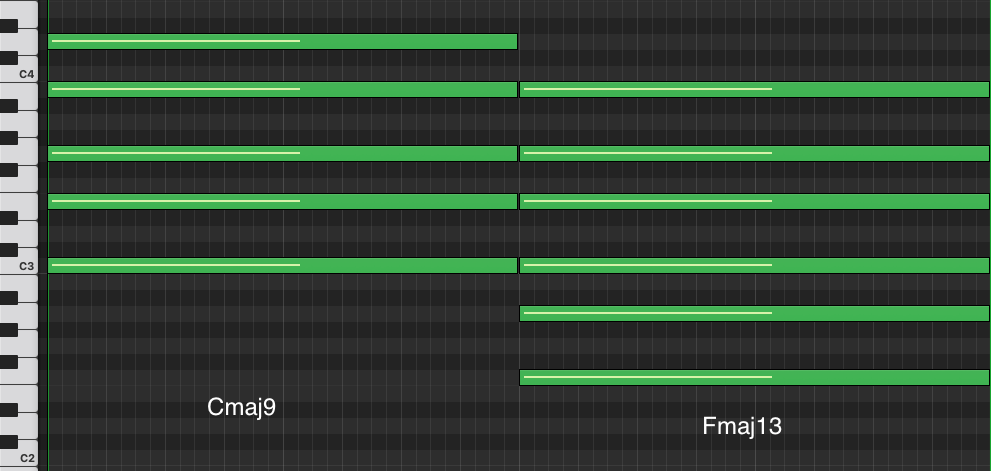
Going from the tonic chord to the subdominant chord is one of my favourite chord progressions across all genres.
It feels like a musical hug.
You can take a simple C-F chord progression and jazz it up by extending the chords to include 7ths, 9ths, and even 13ths.
By adding the 13th to the subdominant chord, you give it a dominant feel that makes you want to resolve back to the tonic. This feeling gives the progression a well-rounded sound.
This is the type of progression I use all the time in my lofi piano project, King Somborne.
2. Cmaj9 - Fmaj9 - G11 - Em7 (I - IV- V - iii)
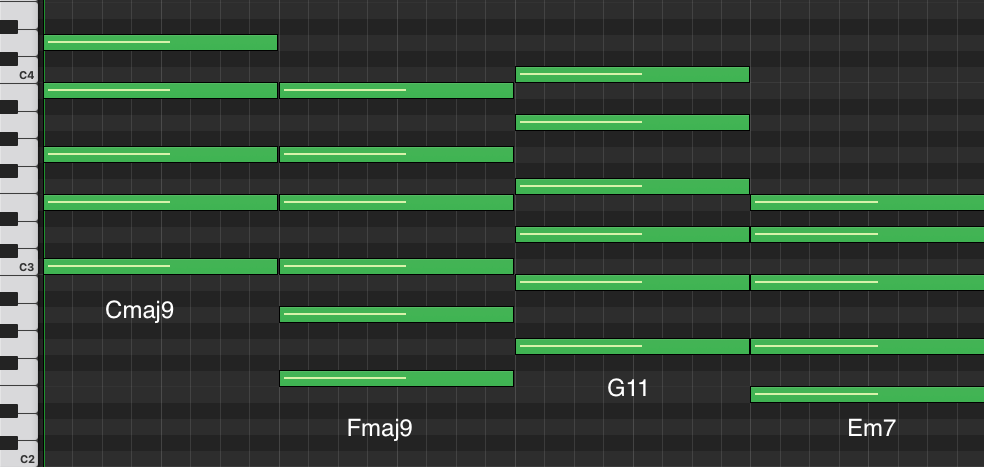
With this chord progression, we are taking one of those incredibly familiar pop progressions and giving it that Lofi aesthetic by extending the chords into the world of jazz.
You could quite easily just use 7th chords in this progression, but by adding those extra notes, it brings in a lot of warmth and emotion.
The surprise movement here is the G11 to the Em7, which has such a lovely cadence to it.

GET THAT AUTHENTIC LOFI SOUND
Grab my Lofi Essentials Kit packed full of MIDI chord progressions, MIDI beats, and samples - Everything you need to get started making authentic Lofi Music
I want this starter pack!3. Cmaj7 - Amin7 - Dmin7 - G7#5 (I - vi - ii - V)
I really love this progression for the simple fact that we have chucked in a cheeky little #5 on the G7 chord.
What this does is create a chromatic movement within the progression from the Dm to the G7 back to the tonic.
If you are feeling fruity, then you can easily substitute the G7#5 with a G7b5. It creates a similar kind of tension but has a slightly softer or duller feel.
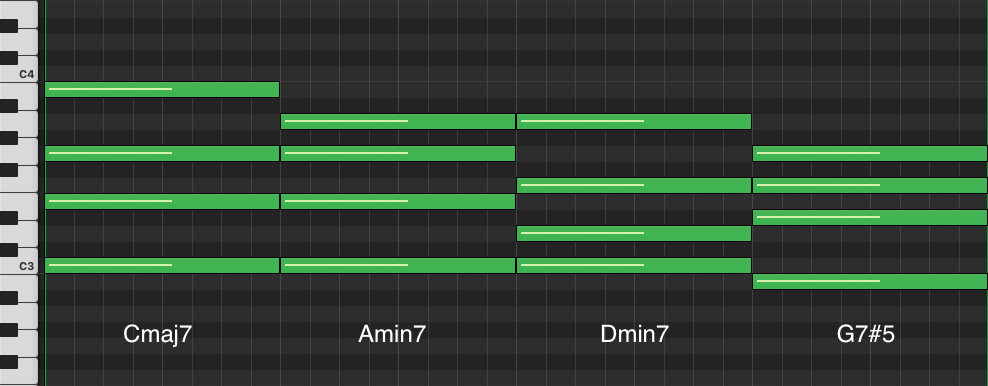
4. Cmaj9 - G7#5 - Amin11 - Fmaj9 (I - V - vi - IV)
This Lofi chord progression epitomises what I love about music; everything is just tension and release.
And that is what this progression does so well.
The move to the G7 creates tension, and the move to the Amin creates a release. Then the move to the Fmaj9 creates tension, and moving back to the Cmaj creates a release.
This one would be really good if it were syncopated to highlight this rhythmic cadence.
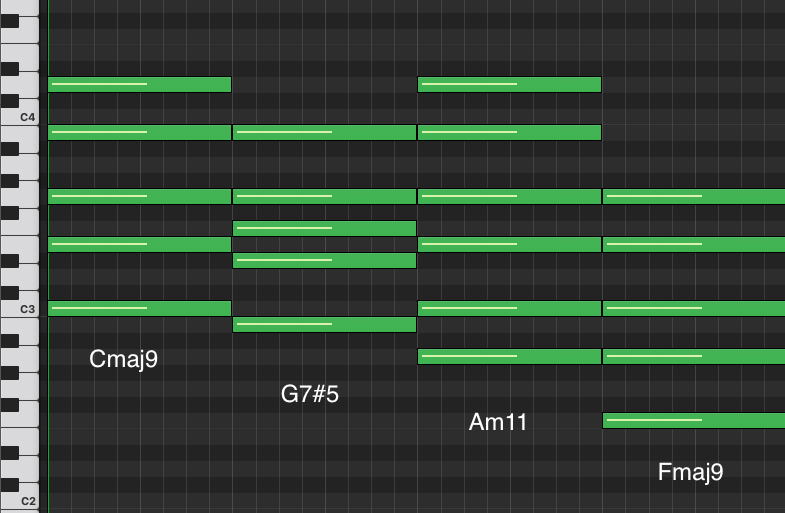
5. Cmin9 - Gmin9 - Cmin9 - G7b9aug5 (i - v - i - V)
I’ve given you two options here because I often like to utilise both the minor dominant chord and the major dominant chord. Both have very different qualities.
Just to emphasise that I have extended the G7 to include not just a b9 (Ab) but also an augmented 5th (D#).
You won’t believe me until you listen to it, but that G7b9aug5 actually feels quite soft and not nearly as jarring as you would expect.
By combining both the major and minor dominant chords, this progression has a lot of melodic possibilities.
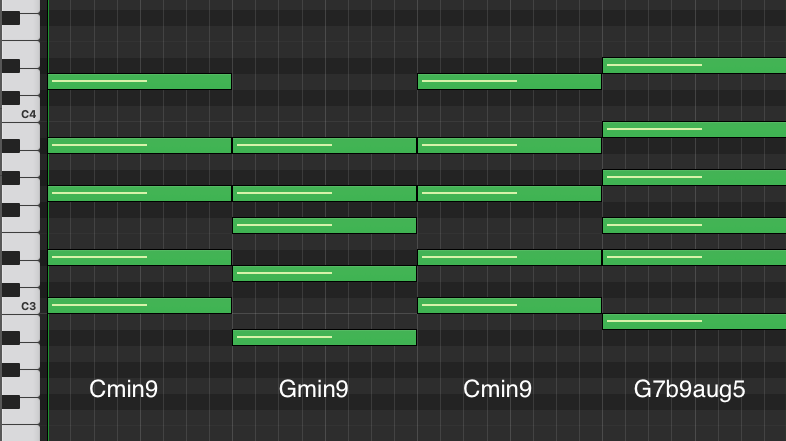
6. Cmin11 - Gmin11 - Cmin9 - Bdim7 (i - v - 1 - vii)
This progression has a similar feel to the previous one in that it relies heavily on the 1-5-1 cadence, but the change is in the final chord of the progression.
I have added a diminished 7 chord to really bring the tension so that the return to the Cmin11 feels a lot more cosy and homely.
Feel free to combine these two progressions to create an 8-bar progression of your own.
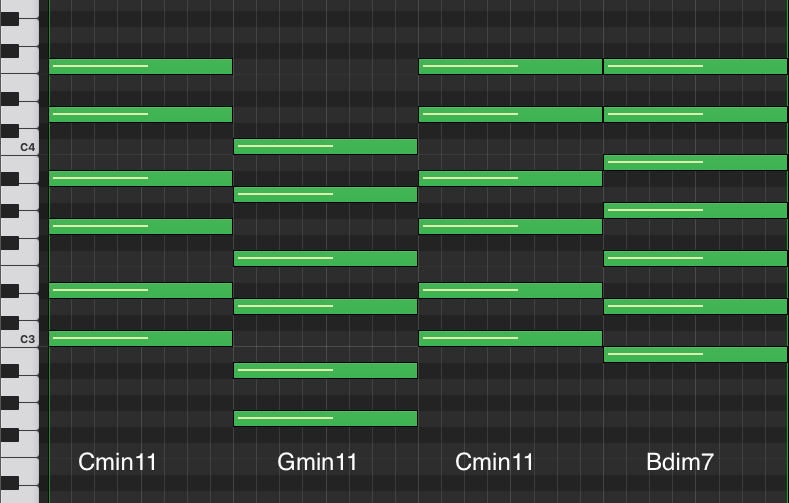
7. Cmin11 - F7 - Abmaj7 - Ebmaj7 (i - IV - VI - III)
This is one of those progressions that feels like it is constantly unresolved, and yet it never feels weird.
In fact, it feels akin to that moment when you are learning to juggle and you finally realise you are juggling (and then drop the balls).
Sorry, weird analogy.
The culprit for this is the dominant IV chord, the F7. This is a borrowed chord from another key and so feels a little out of place, and yet when it drops down to the Abmaj7, it feels like it makes total sense.
Clever stuff.
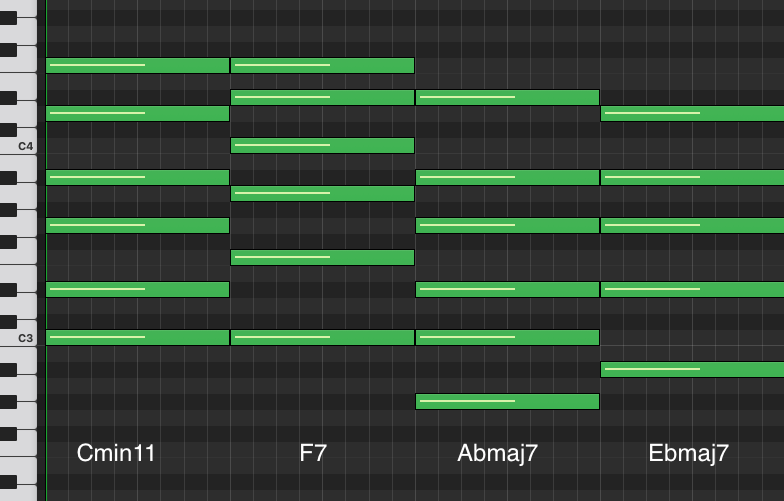
8. Cmin11 - Fmin11 - Cmin11 - G7b5 (i - iv - i - V7)
This chord progression does two things that I really like.
The first is that it is the good old I-IV-V progression that got me through so many hours, no, years of guitar playing.
The second thing is the use of the dominant 7 chord in the minor key. I use this all the time in my trailer music, specifically my neoclassical stuff because you get the mellow vibes of a minor key and the hard tension of a 7th chord.
Winning!
As before, if you find yourself using a dominant 7 chord, you can utilise a b5 or a #5 to up the tension somewhat.
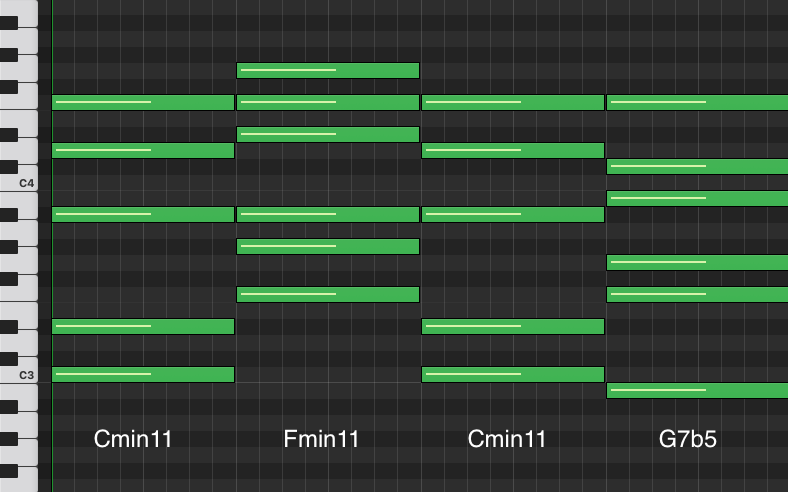

GET THAT AUTHENTIC LOFI SOUND
Grab my Lofi Essentials Kit packed full of MIDI chord progressions, MIDI beats, and samples - Everything you need to get started making authentic Lofi Music
I WANT THIS STARTER PACK!!!9. Cmin9 - Dbmin7 (i - bii)
Two-chord sequences are the dark horses of music composition.
So many people overlook how effective they can be and also how much easier they make it for you as a composer and producer.
This little 2 chord sequence is by no means an exception to that rule.
The reason that this chord progression works so well is that it lends itself to simple stepwise melodies. When you use simple step melodies, you are much more likely to create an addictive little hook for your track.
Awesome.
This one also lends itself nicely to slightly darker-feeling Lofi Hip Hop, which I always think is a nice departure from a lot of the sweeter-sounding tracks.
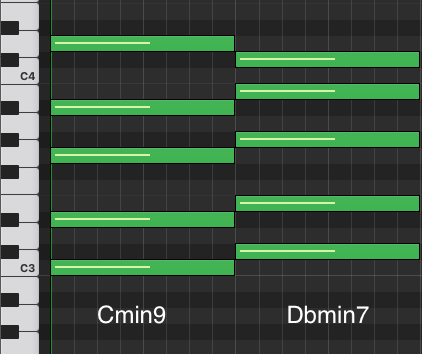
10. Cmaj7 - Bmin7 - Dmin7b5 (I - VII - ii)
This chord progression is to Lofi Hip Hop what the progression I-IV-V is to punk music. It’s an absolute staple that never gets boring.
Why?
Two reasons:
- Changing the 7th chord from a half diminished chord to a min7 chord. This basically means that rather than having a flattened fifth note in the B chord (which is F natural), we have an F# instead, which gives this movement more stability
- The use of the half diminished chord on the Dmin. This means that rather than having an A natural, we have an Ab, which naturally wants to resolve down to the G in the tonic chord.
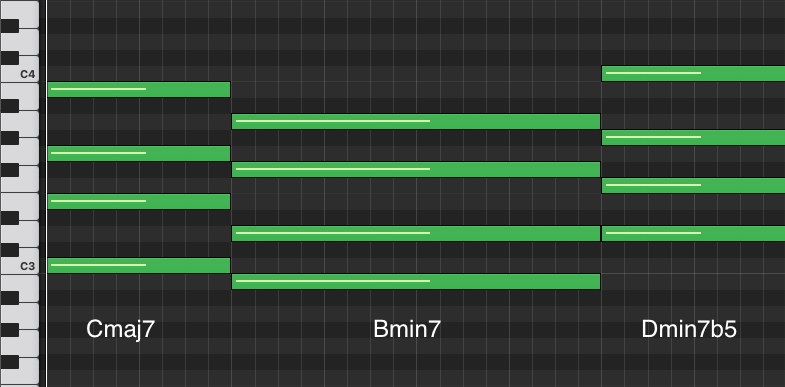
11. Cmin11 - Bdim7 (i - vii)
I overlooked this chord progression for years. Most probably because it is one of those ones that you naturally do on a piano when you are just messing about with triads.
Well, I did anyway.
Now, I hear this one in a completely new light. In fact, whenever I heard this, I immediately heard a full Lofi track playing in the background…in my imagination, that is.
This progression really shows the sheer joy you can have with just 2 chords.
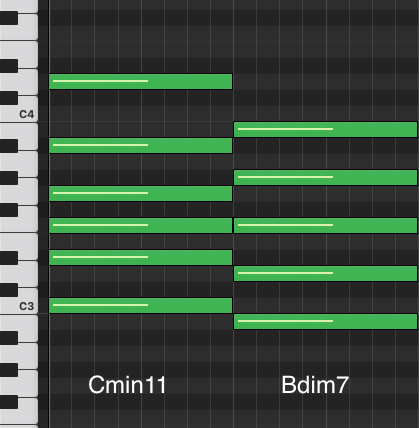
12. Cmin9 - Bbmaj7 (i - bVII)
What works here is the soft tension created by both chords. Even the tonic creates its own sort of tension. As well as that, they both feel like they resolve as well.
If ever there was a little progression that had a wonderful balance of both jazzy tension-inducing chords and sweet simplicity, then this is it.
You can extend it as well by turning the Bbmaj7 into a Bbmaj9. Doing that then creates a mirror of the chord movement between the D in the Cmin9 and the C in the Bbmaj9.
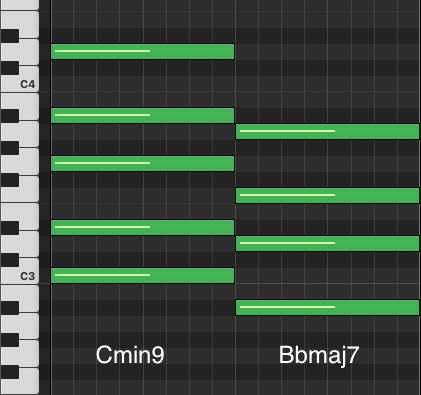
13. Cmin9 - Fmin11 - Dmin7b5 - G7#5 (i - iv - ii - V)
I thought I would end on this delightful little number.
We have already seen the I-IV progression on this list, but I wanted to tack on two chords to create a double whammy of tension.
The half diminished second chord and the augmented 7 chord. Combining these with the sweet sounds of the I-IV progression really does create the perfect Lofi vibe.
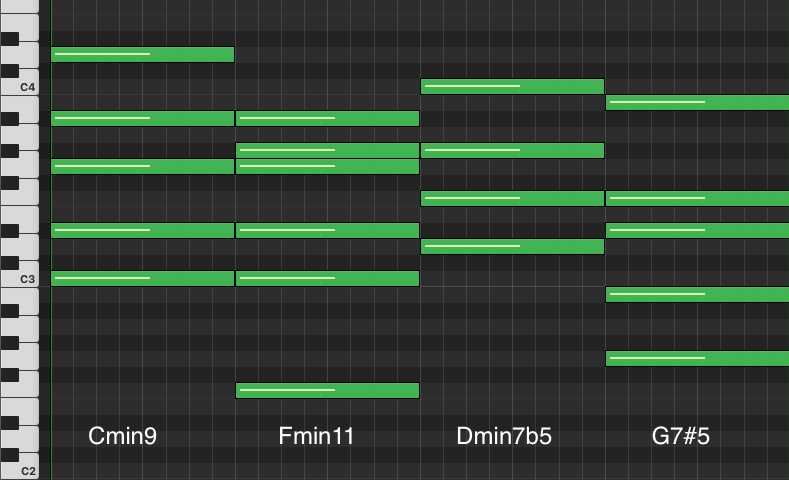
How to make your chord progressions sound more "Lofi"
The wonderful thing and the annoying thing about chord progressions are that they are all the same across all the genres.
You can have a piece of classical music using the I-IV-V progression and also a piece of hardcore grime using that very same progression.
And yet they sound very different.
So, how do you get your standard chord progressions to sound more Lofi?
Extend your chords
The answer is simple: extend the chord voicing to include 7ths, 9ths, 11s, and 13ths.
Doing this opens your chords into the world of jazz and, therefore, the world of Lofi Hip Hop, which derives a lot of its harmonic language from jazz.
For example, if you have a simple progression of C-Am-F-G. You can make that sound more Lofi by turning them all into 7th chords: Cmaj7 - Amin7 - Fmaj7 - G7.
Here is a checklist to help you out:
- When using the dominant chord (chord number V), try extending to a dominant 7 (b7 in the chord) and even changing the 5th note of the chord to a #5 or a b5. G7b5, for example.
- When you are using any minor chords - jazz them up by turning them into min7, min9 or min11 chords
- When you are using any major chords, extend them to maj7 or maj9 or maj13 chords
Explore different voicings
Voicings and chord inversions are a musical way to label the order of the notes in a chord.
To explore chord voicings, you can experiment with which notes are played in what order.
For example, let's take a Cmaj9 chord, which contains the notes C-E-G-B-D.
You could try these different voicings:
- E-C-D-G-B
- G-B-D-E-C
- C-B-D-G (remove the fifth altogether because it is not essential to the harmony)
When you do this, you also start to open the chord and give the notes more room. This is a great thing to explore when writing for an orchestra. I learnt this lesson when I recorded with an orchestra at Abbey Road.
Apply Lofi Effects
Remember when I mentioned that lofi music comes from low-quality gear, analogue tape, and vinyl?
Once you've explored chord extensions and voicings, you can start adding lofi effects to make your progression sound like an old recording.
These effects essentially emulate the characteristics of vintage equipment. Here's what each effect replicates:
- EQ - Mimics the limited frequency response of old microphones and speakers (reduced highs and lows)
- Saturation - Recreates the warm distortion from analogue tape and tube amplifiers
- Noise - Adds the hiss from tape and the crackle from vinyl records
- Reverb - Simulates the natural room ambience of old recording spaces
- Delay - Emulates tape echo machines and the slight timing imperfections of analogue gear
Download My Free MIDI pack of 13 Lofi Chord Progressions
⬇ ⬇ ⬇ ⬇ ⬇ ⬇ ⬇ ⬇ ⬇ ⬇ ⬇ ⬇ ⬇ ⬇ ⬇
These files are part of my Lofi Essentials Starter Pack.
When you download these files and load them into your DAW, I recommend that you play around with the chord voicing.
What I mean by this is that you can move some of the chord’s notes up or down an octave and just have a little fun exploring.
I have purposefully kept the chords mostly stacked in thirds to make it obvious, but by all means, extend or compress those voicings.
You're a legend!


GET THAT AUTHENTIC LOFI SOUND
Grab my Lofi Essentials Kit packed full of MIDI chord progressions, MIDI beats, and samples - Everything you need to get started making authentic Lofi Music
I want this starter pack!Last updated on 8/10/2025






